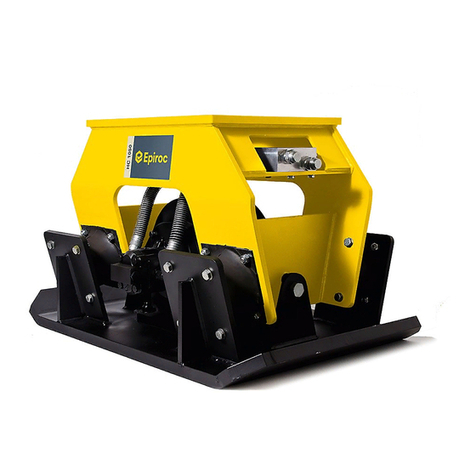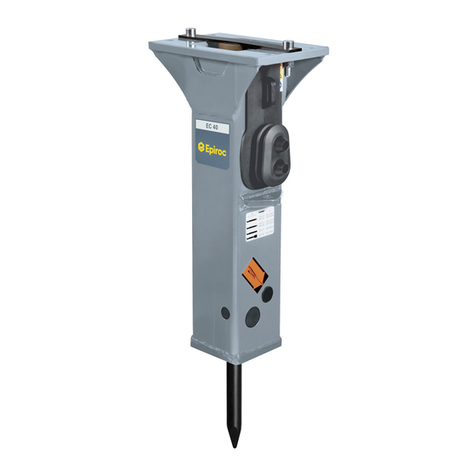Epiroc Secoroc COP 44 Specifications

Secoroc COP 44
down-the-hole hammer
Operator’s instructions
Spare parts lists

2
Any unauthorized use or copying of the contents or any part
thereof is prohibited.This applies in particular to trademarks,
model denominations, part numbers and drawings.
© Copyright 2018
Epiroc DrillingTools AB, Fagersta, Sweden
Contents
Safety regulations �������������������������������������������������������3
Technical data..................................................................................... 3
General �������������������������������������������������������������������������4
Application (drill rigs) ....................................................................... 4
Technical description......................................................................... 4
Preparing to drill ����������������������������������������������������������5
Hose connection ................................................................................ 5
Setting-up the rig............................................................................... 5
Drilling ��������������������������������������������������������������������������6
Rotation to the right .......................................................................... 6
Collaring ............................................................................................. 6
Feed and rotation............................................................................... 6
Feed force........................................................................................... 6
Rotation speed ................................................................................... 7
Flushing — air blowing ..................................................................... 7
Drilling in wet holes........................................................................... 7
Water injection................................................................................... 7
Foam injection ................................................................................... 8
Tools������������������������������������������������������������������������������8
Tools for removing the drill bit and top sub from the DTH hammer........... 8
Removing the drill bit��������������������������������������������������9
Breaking the driver-chuck joint using percussion only ........... 9
Breaking the driver-chuck joint using the bit removal tool ............ 9
Dirt in the hammer������������������������������������������������������9
Other instructions������������������������������������������������������ 10
Wear of driver chuck and hammer cylinder .................................. 10
Checking the wear of the driver chuck and cylinder ..................... 10
Shimming......................................................................................... 10
Assembly of the drill bit and driver chuck ......................................11
Instruction for disassembling of disc spring unit ..........................11
Plastic footvalve in the bit shank �����������������������������12
Replacing the foot valve.................................................................. 12
Protrusion of the foot valve ............................................................ 12
Removing the foot valve ................................................................. 12
Fitting a new foot valve................................................................... 12
Regrinding the drill bit ����������������������������������������������12
Grinding equipment ��������������������������������������������������13
Lubrication �����������������������������������������������������������������14
Lubricators ....................................................................................... 14
Choice of lubricating oil .................................................................. 14
Recommended lubricants ............................................................... 14
Wear limits �����������������������������������������������������������������15
Trouble shooting��������������������������������������������������������15
Overhauling...................................................................................... 15
Spare parts list�����������������������������������������������������������16

3
Safety regulations
• Before starting, read these instructions carefully.
• Important safety information is given at various points in these
instructions.
• Special attention must be paid to the safety information con-
tained in frames and accompanied by a warning symbol (triangle)
and a signal word, as shown below.
Indicates immediate hazards which WILL result in serious or
fatal injury if the warning is not observed.
DANGER
Indicates hazards or hazardous procedures which COULD result
in injury or damage to equipment if the warning is not observed.
WARNING
Indicates hazards or hazardous procedures which COULD result
in injury or damage to equipment if the warning is not observed.
CAUTION
• Read through the operator’s instructions for both the drill rig
and the DTH hammer thoroughly before putting the DTH hammer
into service. Always follow the advice given in the instructions.
• Use only authorized parts. Any damage or malfunction caused
by the use of unauthorized parts is not covered by Warranty or
Product Liability.
The following general safety rules must also be observed:
• Make sure that all warning signs on the rig remain in place and
are free from dirt and easily legible.
• Make sure there are no personnel inside the working area of the
drill rig during drilling, or when moving the rig.
• Always wear a helmet, goggles and ear protectors during drill-
ing. Also observe any local regulations.
•The exhaust air from air driven hammers and grinding machines
contains oil. It can be dangerous to inhale oil mist. Adjust the
lubricator so that the correct rate of lubrication is obtained.
• Make sure that the place of work is well ventilated.
• Always check that hoses, hose nipples and hose clamps are
properly tightened and secured, and that they are not damaged.
Hoses that come loose can cause serious injury.
• Local regulations concerning air hoses and connections
must always be strictly observed.This is especially the case if
the DTH-hammer is to be operated at pressures above 10 bar
(145psi).
• The machine must not be used for purposes other than those
prescribed by Secoroc. See “Application” on page 4.
Technical data
Dimensions and weights COP 44
Length without drill bit, mm (in) 1034 (40.7)
Length with optional thread, mm (in)
Length excl. thread, mm (in) 958 (37.7)
Outside diameter,mm (in) 98 (4.0)
QHD design, mm (in)
Piston diameter, mm (in) 78 (3.1)
Piston weight,
kg (lbs) 7,1 (16)
Stroke, mm (in) 115 (4.5)
Top sub thread (standard) API Reg 2 3/8
(Optional) API Reg
Wrench flat on top sub, mm (in) 65 (2.6)
Weight without drill bit, kg (lbs) 38 (84)
QHD design, kg (lbs)
Drilling parameters
Working pressure, bar (psi)
Rotation speed, r/min 25–80
Feed force, kN (lbs) 5–15
(1100-3300)
Feed force at 16 bar, kN (lbs) 10 (2000)
Recommended bit size, mm (in) 110-125
(4.3–4.9)
QHD design, mm (in)
Bit shank IR 340A
Air consumption, different working pressures, l/s
Bit shank IR 340A
10.5 bar (150 psi) 105
16 bar (230 psi) 165
20 bar (290psi) 205
25 bar (360 psi) (estimated consump.) 255
Blowing capacity, l/s
6 bar (87 psi) 317 (670)
10.5 bar (150 psi) 495 (1050)
Impact rate, strokes/min
10,5 bar (150 psi) 1420
16 bar (230 psi) 1680
20 bar (290 psi) 1860
25 bar (360 psi) 2100
Penetration rate in Swedish granite, 2200 bar, 30% SiO,
mm/min (Standardized laboratory test)
Bit size, mm (in) 115 (4.5)
10,5 bar (150 psi) 310 (61)
16 bar (230 psi) 510 (101)
20 bar (290 psi) 640 (125)
25 bar (360 psi) 800 (157)
Performance figures are average values for new hammers at sea
level. Specifikations and other data subject to alteration without
prior notice.

4
General
The down-the-hole hammer is a percussion hammer drill. As the
name implies, the hammer works down the hole at the end of the
drill string, where the impact piston strikes the drill bit directly.
Compressed air is led to the hammer via the rotation spindle and
drill pipes. Exhaust air from the hammer is discharged through
holes in the drill bit and used to flush clean the drill hole. Rotation
is provided by a rotation unit on the feed beam and transmitted to
the hammer via the drill pipes.The drill pipes are threaded so that
the drill string can be extended as drilling progresses and the hole
becomes deeper. Feed force is also transmitted to the hammer via
the rotation unit and drill pipes. One of the main advantages of
DTH hammers is that the drilling rate is not affected very much by
the length or depth of the drill hole.
DTH hammers are very productive and have many applications
in the mining, quarrying, civil-engineering and water-well drilling
industries.
Application (drill rigs)
A= Drill pipe
B= Down-the-hole hammer
C= Drill bit
D= Rotation unit
E= Feed
F= Drill rig
Secoroc COP down-the-hole
hammers are designed for use
on DTH or ITH drill rigs.They
can also be used on rotary and
auger type drill rigs, provided
that such rigs meet the
specifications for DTH applica-
tions.The main demands on the
drill rig are as follows:
• It should be equipped with
a rotation unit that has a vari-
able rotation speed of 0–90 r/
min and a rotation torque of
750–3000 Nm (75–300 kpm).
Naturally, the torque demand
for a recommended rotation
speed will depend on the ham-
mer size and bit diameter.
• A variable feed force of 3–43
kN (300–4300 kp) for shallow
holes (less for deeper holes, bearing in mind the weight of the
drill string). Obviously, the feed must be strong enough to pull the
hammer and drill string out of the drill hole.This is an especially
important consideration when drilling deep holes.The weight of
the drill string varies between 9 and 34 kg/m, depending on the
pipe- and bit diameters.
Technical description
The Secoroc COP down-the-hole hammer and drill bit operate at
the bottom of the hole as a unit.
COP hammers have a long cylinder D, which houses a check valve
B, compression ring C, impact piston F, control tube E, stop ring
Hand drill-bit shank J� The back end of the cylinder is closed by a
threaded top sub A� The top sub has a male thread for connection
to the drill pipes, and is provided with wrench flats.
A driver chuck Kthreads into the front end of the cylinder.
A
B
C
D
E
F
L
H
J
K
The splined union between the driver chuck K
and bit shank Jtransmits rotation to the drill
bit.The front end of the driver chuck transmits
feed force to the drill bit.The split stop ring H
limits axial movement of the drill bit.The
check valve Bprevents water from entering
the hammer through the driver chuck when
the compressed air supply is shut off.
When feed force is applied, the drill bit is
pushed into the hammer and pressed against
the front of the driver chuck.The impact
piston strikes the shank of the drill bit directly.
The passage of compressed air through the
hammer is directed by the piston and control
tube, both of which have regulating ducts.
A built-in damping chamber cushions the
piston return stroke and increases the impact
frequency.
After the compressed air has imparted most
of its pressure energy to the piston, it is led as
exhaust air through the foot valve L into the
central gallery in the drill bit.The exhaust air
then emerges as flushing air through holes in
the drill bit head.This gives efficient transpor-
tation of cuttings out of the drill hole.
When the hammer is lifted off the bottom of
the hole, the piston drops into the air blowing
position.This disengages percussion and
gives air blowing only, i.e. a large volume of
air flows straight through the hammer and
drill bit. During drilling, air blowing starts if
the drill bit loses contact with the bottom of
the hole.
The hammer starts operating again as soon
as the bit is pressed back against the driver chuck. Air blowing is
used when powerful flushing of the drill hole is required, and in
certain difficult drilling conditions.
Friction between the drill pipes and the hole wall can sometimes
reduce the penetration rate.This can often be counteracted by
increasing the air pressure to give more impact power and faster
penetration.
Together with Epiroc ODEX equipment, COP hammers are used
for simultaneous drilling-and-casing through overburden. When
used with Secoroc precision drilling equipment, COP hammers
are capable of drilling long, straight holes.
Preparing to drill
Hose connection
Connecting and securing the air hoses
For a compressed air system to be
efficient, reliable and economic,
there must be:
• sufficient compressed-air capaci-
ty (volume and pressure);
• minimal pressure loss between
the compressor and the hammer;
• minimal air leakage between
couplings.
This can be realized by ensuring
that:
• the correct size of compressor is
selected;

5
• the correct hose size is used between the compressor and the
hammer;
• there is no leakage in hose connections between the compressor
and hammer.
• Compressed-air hoses between the compressor and the
drill rig must be secured by means of an external or internal
safety wire, which must be fastened safely to the drill rig. If
the DTH hammer is to work at pressures above 10 bar (145
psi), any local regulations regarding air hoses and couplings
must be strictly observed.
• Always check that hoses, hose nipples and hose clamps
are not damaged, and that they are properly tightened and
secured.
DANGER
• Always check the condition of drill string components. Bent
or worn pipes can cause damage and excessive wear to the
hammer and rig.
CAUTION
Setting-up the rig
AB
Before drilling with
the DTH hammer,
the rig must be
set-up correctly in
order to give
stability and safety.
If this is not done,
the effects of feed
force and rotation
torque can cause
the rig to move.This will have a negative effect on drilling,
especially when drilling deep, straight holes.
When setting up a drill wagon or crawler drill rig, a stable three-
point set-up must be obtained, with the weight of the rig distribut-
ed between the base of the feed beam and the two rear corners of
the rig. It is of the utmost importance that the rear loading points
are as far to the rear of the rig as possible, with most of the rig
weight being loaded on to the base of the feed.
When drilling in soil or other non-consolidated formations, the
weight of the rig must not be loaded on to the feed near the
mouth of the hole, since this could easily cause the hole to cave-
in. Instead, the load should be distributed some distance to either
side of the hole. Suitable support can be obtained by placing a
sturdy U-beam under the base of the feed beam, and support-
ing the beam on planks at both ends. A two inch (50 mm) plank
should then be placed inside the U-beam to prevent mechanical
chatter and damage to the base of the feed beam.
If the rig is wheel-bound, it should be raised off the ground com-
pletely using the jacks, so that all wheels are clear of the ground.
•The rig must be set-up correctly in order to give stability
and safety. If this is not done, the effects of feed force and
rotation torque can cause the rig to move or even to over-
turn.This can incur the risk of serious or fatal injury as well
as damage to the drill rig and equipment.
DANGER
• Heavy lift.Take care when
handling the hammer.The
hammer and its internal
components are heavy and
difficult to handle, especially
in the case of the larger
hammers.
When lifting using mechanical lifting equipment, sling the
hammer as shown in the fig. Alternatively, a lifting-eye cou-
pling can be screwed on to the top sub.
•Transportation. Do not let the hammer lie unsecured on a vehi-
cle or drill rig. Always secure the hammer for transportation.
WARNING
• Always wear goggles during drilling!
•The exhaust air from the hammer (and also from the top
sub if a unit for extra flushing is fitted) has a very high
velocity. Objects such as small stones, drill cuttings, sand,
earth and oil residue that are entrained in the flushing air
can cause serious injury to unprotected eyes. Pay special
attention to this danger during collaring, when a top sub with
extra flushing is in use, an when the hammer is fed through
the drill steel support or down into the hole.
WARNING
Drilling
Rotation to the right
DTH hammers must be rotated to the RIGHT
(clock wise) during drilling, since the driver
chuck and top sub are threaded into the
cylinder with RIGHT-HANDTHREADS.
Rotation must always be to the right when
the hammer is operating. Left-hand rotation
(or no rotation) will cause the driver chuck to
loosen, which could mean losing the drill bit
(or even the entire hammer) down the hole.
The drill string should be rotated to the right
even when the hammer is not operating.
For example, this should be done when
cleaning the drill hole and when lifting up the drill string. It can
be said that rotation to the right should be switched on as long
as other operations are in progress with the hammer in the hole.
The risk of the drill bit working loose should also be considered
when breaking the joints between drill pipes. When adjusting the
breaking wrenches, bear in mind that the drill string must not be
rotated anti-clockwise any more than is absolutely necessary.
• Always switch on rotation to the right before starting the
feed or hammer.
• Let the hammer rotate to the right (clockwise) even during
lifting or lowering of the hammer.
• Do not switch off rotation to the right until all other func-
tions have been switched off.
IMPORTANT
Table of contents
Other Epiroc Construction Equipment manuals
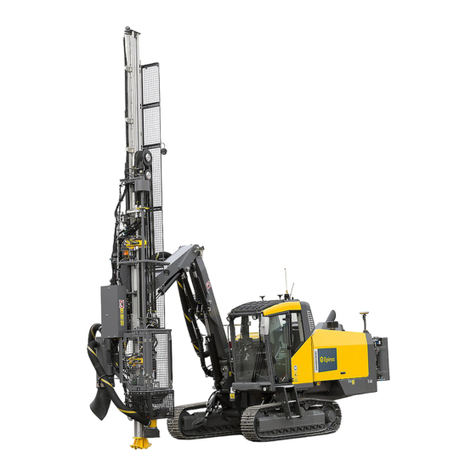
Epiroc
Epiroc SmartROC T35 User manual
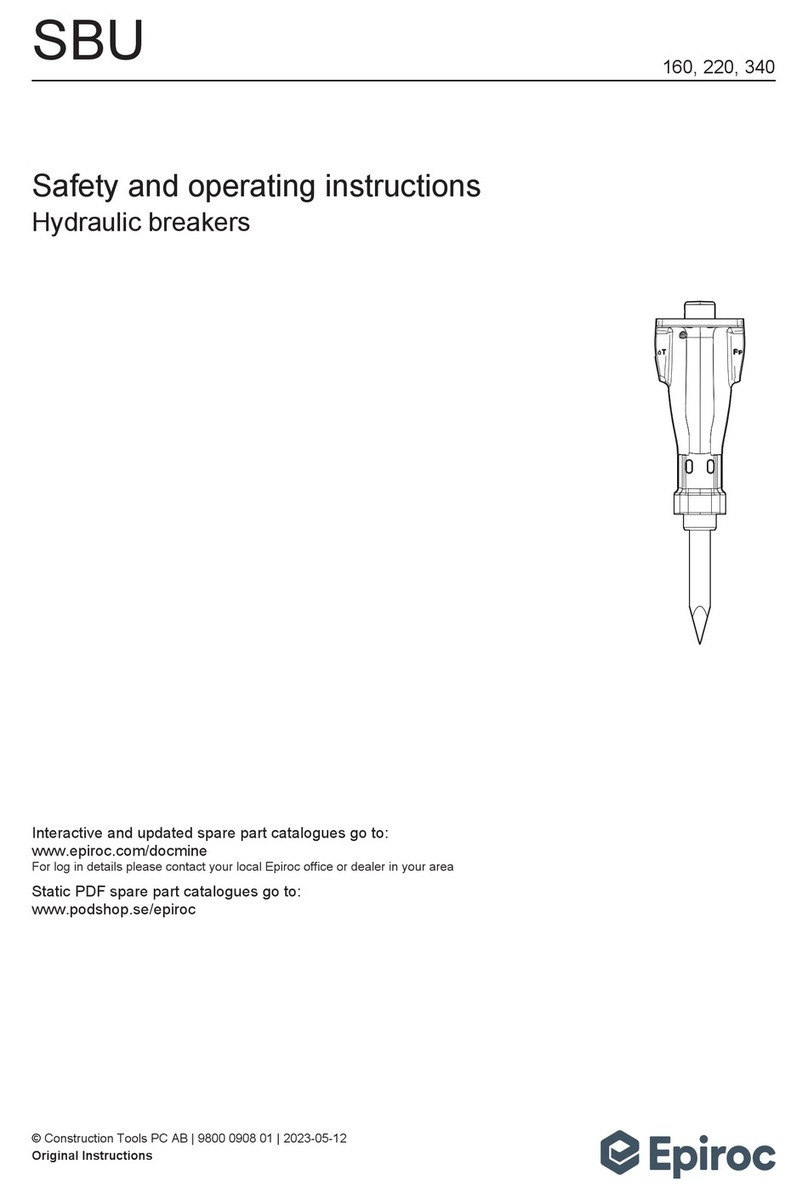
Epiroc
Epiroc SBU 160 Maintenance and service guide
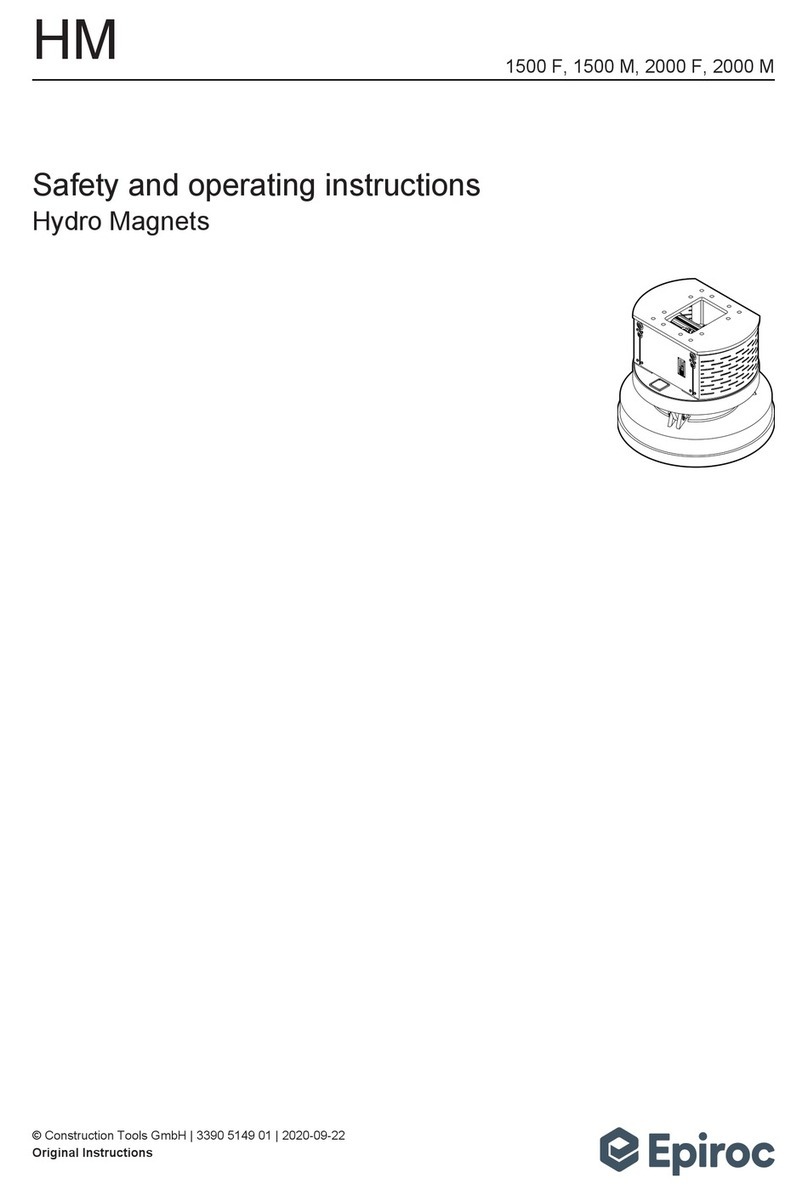
Epiroc
Epiroc HM Series Maintenance and service guide

Epiroc
Epiroc COP M6 Specifications
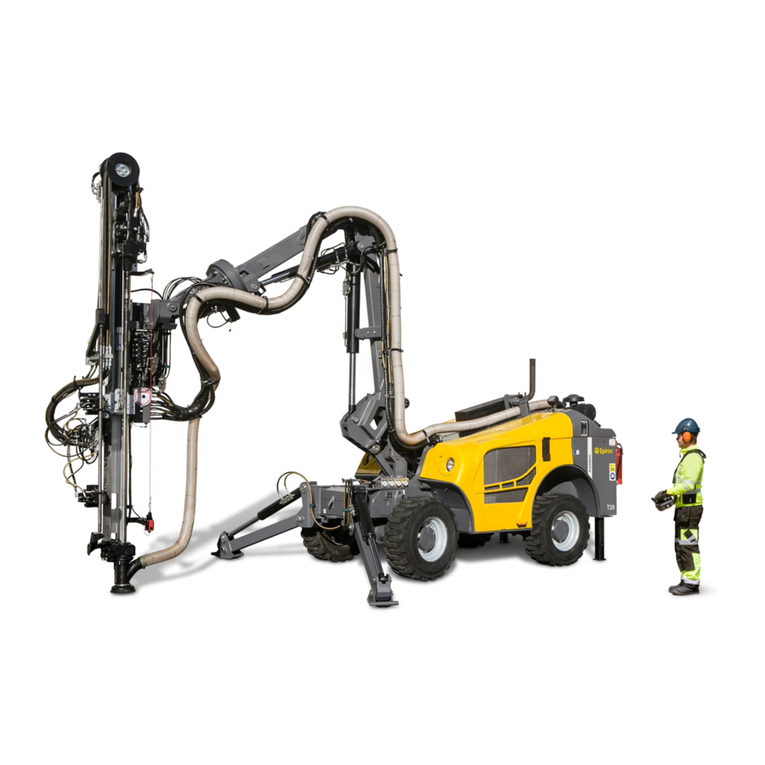
Epiroc
Epiroc Flexi ROC T20 R Instructions for use
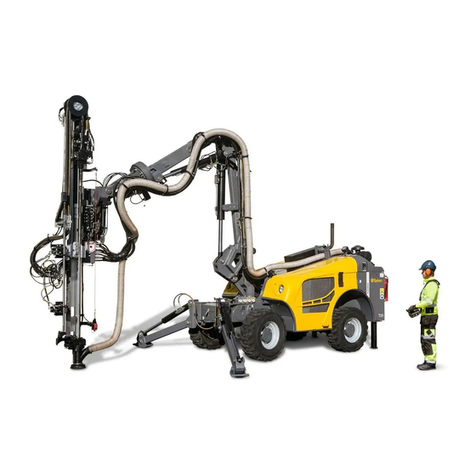
Epiroc
Epiroc FlexiROC T20 R Specifications
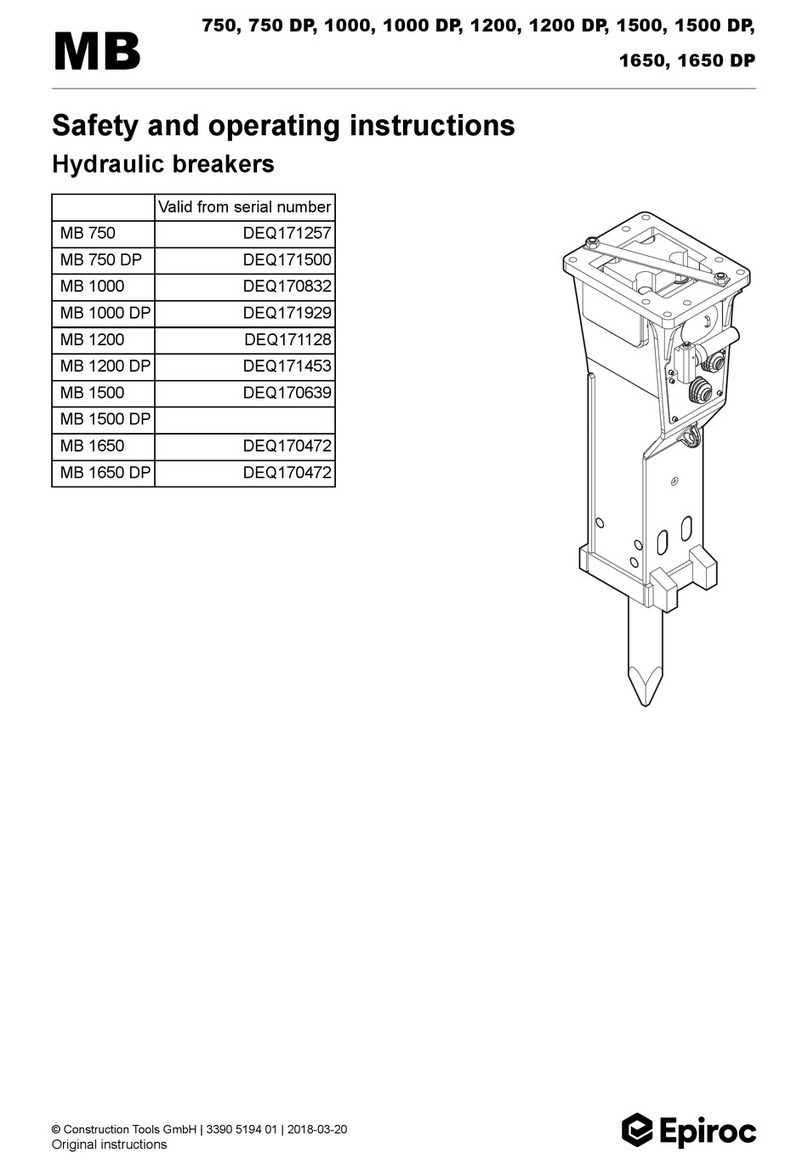
Epiroc
Epiroc DEQ171257 User manual
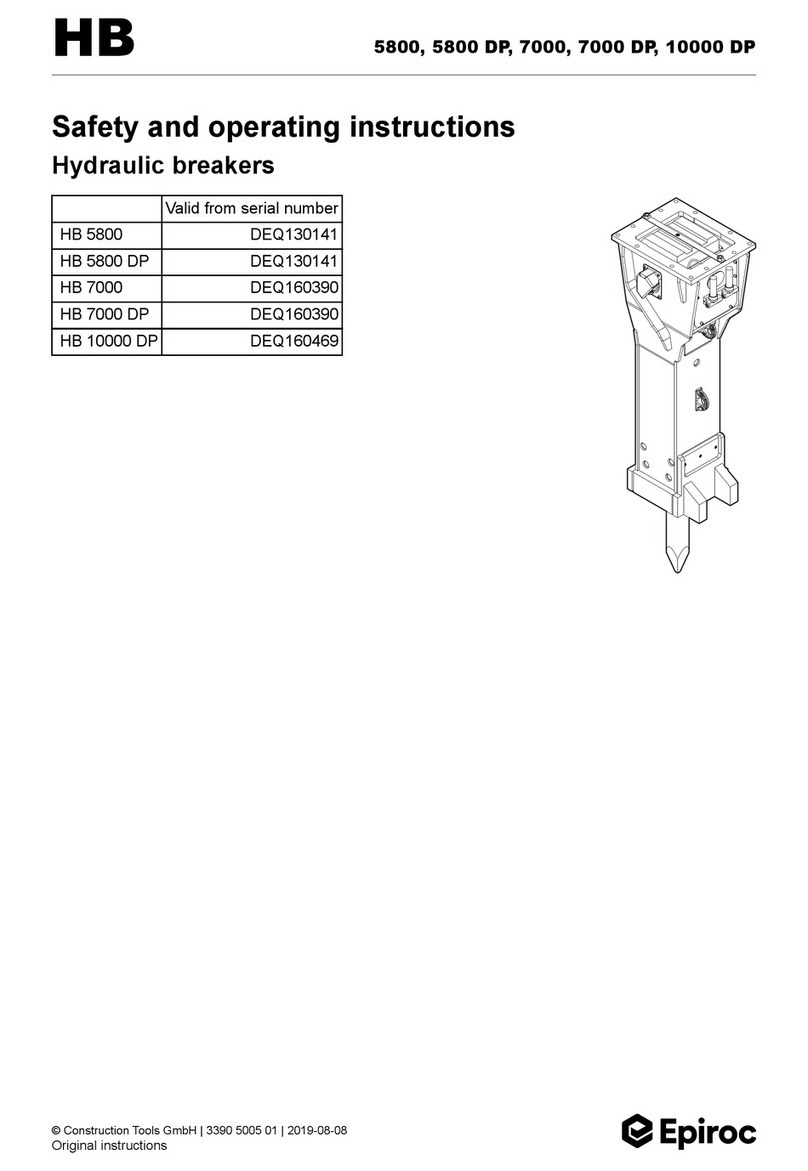
Epiroc
Epiroc DEQ130141 Maintenance and service guide

Epiroc
Epiroc EC 90T User manual
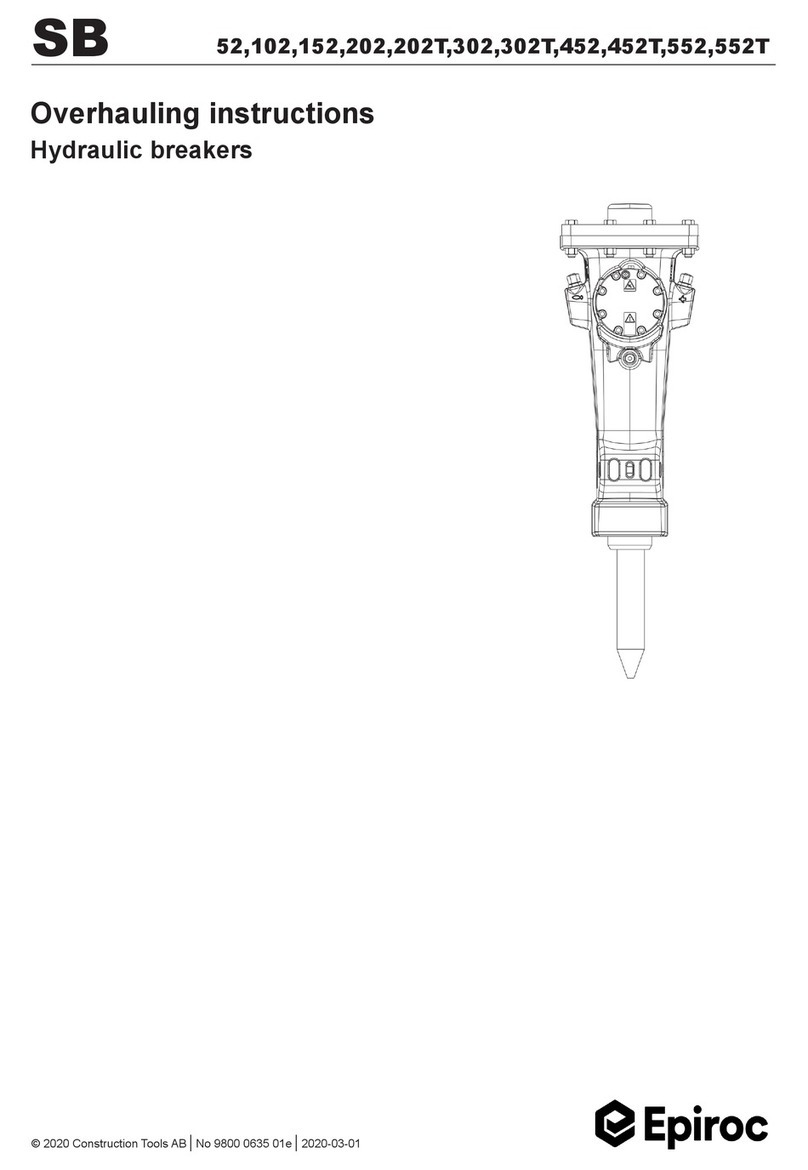
Epiroc
Epiroc SB 52 User manual

